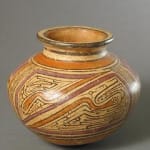Cocle Terracotta Round Vase, 500 CE - 1000 CE
Terracotta
5.5
PF.4063
Further images
Archaeological excavations in the Cocle Province located in Central Panama have revealed that an ancient civilization once inhabited these lands. The findings suggested that the so-called Cocle culture arose around...
Archaeological excavations in the Cocle Province located in Central Panama have revealed that an ancient civilization once inhabited these lands. The findings suggested that the so-called Cocle culture arose around 500 A.D. and lasted until about 1000 A.D. Although their dating is roughly contemporaneous with the Diquis culture to the north in modern day Costa Rica, the art they left behind suggests that they were a unique, independent civilization. Cocle art, which consists primarily of unslipped or buff slipped pottery and terracotta sculptures, is distinguished by their polychrome hues and lively asymmetrical motifs which often include animal themes.
The round vase is an important part of the beautiful designs created in this part of the world. The low neck and flared lip at the top of the vessel add a distinct balance to the piece which has no flat base and therefore must be held or supported at all time. The fluid artwork is found in structured registers throughout the entire vessel, leaving no portion undecorated. The abstract formations throughout the piece give the whole object a strong sense of originality and inventiveness. The earthenware itself is smooth to the touch, adding touch as well as sight to the overall design. Pieces such as these demonstrate artistry at its best and continue to remain timeless.
The round vase is an important part of the beautiful designs created in this part of the world. The low neck and flared lip at the top of the vessel add a distinct balance to the piece which has no flat base and therefore must be held or supported at all time. The fluid artwork is found in structured registers throughout the entire vessel, leaving no portion undecorated. The abstract formations throughout the piece give the whole object a strong sense of originality and inventiveness. The earthenware itself is smooth to the touch, adding touch as well as sight to the overall design. Pieces such as these demonstrate artistry at its best and continue to remain timeless.





